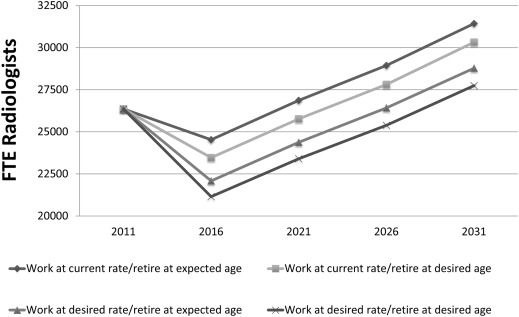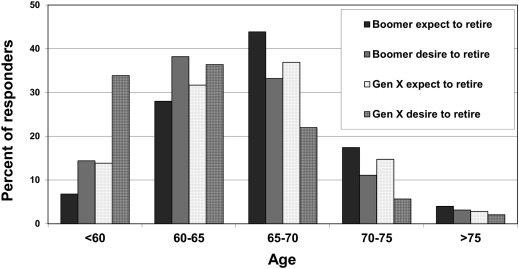Rationale and Objectives
The radiology job market has been described as highly variable, and recent practice hiring surveys predict that the number of available jobs will remain flat. Radiologists may be working more hours and retiring later than desired, activities that influence overall job availability. A national survey was performed to determine the desired work rate and retirement preferences of practicing radiologists, and the responses are used to estimate current and potential future work output and future workforce needs.
Materials and Methods
Practicing radiologists were surveyed regarding current and preferred work level and desired and expected retirement age. A model incorporating these preferences and stratified by age was developed using survey responses and American Medical Association full-time equivalent (FTE) estimates. Available FTE radiologists are estimated under four scenarios from 2016 to 2031 in 5-year intervals.
Results
The model predicts a total of 26,362 FTE radiologists available in 2011, which corresponds to previous estimates. Participants reported working more hours and expecting to retire later than desired, with younger radiologists and women reporting the greatest desired decrease in FTE hours worked. Under each scenario, there is an initial FTE availability in 2016 ranging from 21,156 to 24,537, which increases to between 27,753 and 31,435 FTE by 2031 depending on work rate and retirement patterns.
Conclusions
Practicing radiologists report that they currently work more hours than desired and expect to retire later than they would prefer. If radiologists changed current personal work rate and expected retirement age to meet these preferences, there would be an immediate shortage of FTE radiologists continuing until at least 2020 assuming no other workforce needs changes.
There is currently significant uncertainty regarding the appropriate size of the radiology workforce and the impact of numerous internal and external factors on the availability of jobs . The overall job market has been highly variable over the previous 20 years with extremes of both surplus and shortage , and responses to these imbalances often take several years . Two consecutive yearly practice leader hiring surveys estimate that current demand for radiologists is essentially flat and almost precisely matches the number of new trainees entering the workforce each year .
The exact workforce needs remain difficult to determine but can be useful for practice managers and administrators when estimating staffing requirements. National survey data are used to estimate the full-time equivalent (FTE) hours worked and retirement preferences of currently practicing radiologists. Current and future work output and workforce are modeled under several different possible scenarios using radiologists’ self-reported preferences for part-time employment and early retirement.
Materials and methods
Get Radiology Tree app to read full this article<
Get Radiology Tree app to read full this article<
Get Radiology Tree app to read full this article<
Table 1
Full-time Equivalent (FTE) Weighting for Survey Participant Self-reported Current Work Rates
Response to “Current Time Worked” Weight for Calculated Percent Effort (FTE) Full time 1.0 >80% 0.9 60%–80% 0.7 40%–60% 0.5 <40% 0.2
Table 2
Comparing Calculated Current and Desired Percent Full-time Equivalent (FTE) Effort for Gender and Generation
Gender Period Born Current Percent Effort FTE Desired Percent Effort FTE Female 1925–1945 77.65 74.38 1946–1963 91.01 77.48 1964–1980 91.30 77.76 Male 1925–1945 77.24 69.15 1946–1963 95.54 83.09 1964–1980 99.48 94.00
Get Radiology Tree app to read full this article<
Get Radiology Tree app to read full this article<
Get Radiology Tree app to read full this article<
Results
Get Radiology Tree app to read full this article<
Get Radiology Tree app to read full this article<
Get Radiology Tree app to read full this article<
Get Radiology Tree app to read full this article<
Get Radiology Tree app to read full this article<
Get Radiology Tree app to read full this article<
Get Radiology Tree app to read full this article<
Discussion
Get Radiology Tree app to read full this article<
Get Radiology Tree app to read full this article<
Get Radiology Tree app to read full this article<
Get Radiology Tree app to read full this article<
Get Radiology Tree app to read full this article<
Get Radiology Tree app to read full this article<
Get Radiology Tree app to read full this article<
Get Radiology Tree app to read full this article<
Get Radiology Tree app to read full this article<
Conclusions
Get Radiology Tree app to read full this article<
Acknowledgments
Get Radiology Tree app to read full this article<
References
1. Forman H.P., Larson D.B., Kaye A.D., et. al.: Masters of radiology panel discussion: the future of the radiology job market. Am J Roentgenol 2012; 199: pp. 127-132.
2. Sunshine J.H., Maynard C.D.: Update on the diagnostic radiology employment market: findings through 2007–2008. J Am Coll Radiol 2008; 5: pp. 827-833.
3. Janower M.L., Sunshine J.H.: Too many radiologists? Update. Radiology 1996; 200: pp. 545-549.
4. Bhargavan M., Sunshine J.H., Schepps B.: Too few radiologists?. Am J Roentgenol 2002; 178: pp. 1075-1082.
5. Sunshine J.H., Maynard C.D., Paros J., et. al.: Update on the diagnostic radiologist shortage. Am J Roentgenol 2004; 182: pp. 301-305.
6. Sunshine J.H., Meghea C.: How could the radiologist shortage have eased?. Am J Roentgenol 2006; 187: pp. 1160-1165.
7. Meghea C., Sunshine J.H.: Retirement patterns and plans of radiologists. Am J Roentgenol 2006; 187: pp. 1405-1411.
8. Soni K., Bhargavan M., Forman H.P., et. al.: Who’s underworked and who’s overworked now? An update on radiologist shortage and surplus. Am J Roentgenol 2010; 194: pp. 697-703.
9. Bluth E.I., Truong H., Nsiah E., et. al.: The 2013 ACR Commission on Human Resources Workforce Survey. J Am Coll Radiol 2013; 10: pp. 750-756.
10. Moriarity A.K., Brown M.L., Schultz L.R.: We have much in common: the similar inter-generational work preferences and career satisfaction among practicing radiologists. J Am Coll Radiol 2014; 11: pp. 362-368.
11. Association of American Medical Colleges. AAMC applicants and matriculants data. 2012. Available at: https://www.aamc.org/data/facts/applicantmatriculant/ .
12. Iglehart J.K.: Health reform, primary care, and graduate medical education. N Engl J Med 2010; 363: pp. 584-590.
13. Bhargavan M., Kaye A.H., Forman H.P., et. al.: Workload of radiologists in United States in 2006–2007 and trends since 1991–1992. Radiology 2009; 252: pp. 458-467.
14. Rehani B., Basu P., Ellenbogen P.H., et. al.: The threat to radiologists from the multiple-procedure payment reduction. J Am Coll Radiol 2013; 10: pp. 237-238.
15. Allen B., Levin D.C., Brant-Zawadzki M., et. al.: ACR white paper: strategies for radiologists in the era of health care reform and accountable care organizations: a report from the ACR Future Trends Committee. J Am Coll Radiol 2011; 8: pp. 309-317.
16. Forman H.P., Larson D.B., Kazerooni E.A., et. al.: Masters of radiology panel discussion: hyperefficient radiology—can we maintain the pace?. Am J Roentgenol 2012; 199: pp. 838-843.
17. Forman H.P., Larson D.B., Kaye A.D., et. al.: Masters of radiology panel discussion: women in radiology—how can we encourage more women to join the field and become leaders?. Am J Roentgenol 2012; 198: pp. 145-149.
18. Dall T.M., Gallo P.D., Chakrabarti R., et. al.: An aging population and growing disease burden will require a large and specialized health care workforce by 2025. Health Aff (Millwood) 2013; 32: pp. 2013-2020.
19. Ricketts T.C.: The health care workforce: will it be ready as the boomers age? A review of how we can know (or not know) the answer. Annu Rev Public Health 2011; 32: pp. 417-430.
20. Sommers B.D., Swartz K., Epstein A.: Policy makers should prepare for major uncertainties in Medicaid enrollment, costs, and needs for physicians under health reform. Health Aff (Millwood) 2011; 30: pp. 2186-2193.
21. Cronan J.J., Coleman B.G., Harolds J.A., et. al.: Retirement issues for radiologists and the radiology practice, part 1: a report of the ACR Commission on Human Resources, Subcommittee on Retirement. J Am Coll Radiol 2013; 10: pp. 101-107.

